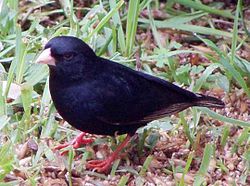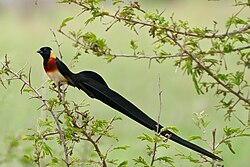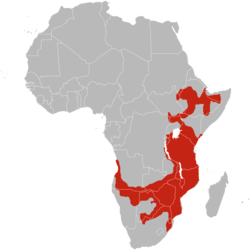| Common name | Scientific name | Range | Host species [a] |
|---|
Cuckoo-finch
 | Anomalospiza imberbis
(Cabanis, 1868) | | Cisticolidae, [4] most commonly Prinia subflava [5] |
|---|
Village indigobird
 | Vidua chalybeata
(Müller, 1776) | | Lagonosticta senegala , Lagonosticta nitidula [6] |
|---|
| Jambandu indigobird | Vidua raricola
Payne, 1982 | | Amandava subflava (primary host), possibly Lagonosticta rara [6] |
|---|
| Barka indigobird | Vidua larvaticola
Payne, 1982 | | Lagonosticta larvata (primary host), Lagonosticta virata [6] |
|---|
| Jos Plateau indigobird | Vidua maryae
Payne, 1982 | | Lagonosticta sanguinodorsalis [b] [6] |
|---|
| Quailfinch indigobird | Vidua nigeriae
(Alexander, 1908) | | Ortygospiza atricollis [6] |
|---|
Dusky indigobird
 | Vidua funerea
(de Tarragon, L, 1847) | | Lagonosticta rubricata [6] |
|---|
| Zambezi indigobird | Vidua codringtoni
(Neave, 1907) | | Hypargos niveoguttatus (primary host), Hypargos margaritatus [6] |
|---|
Purple indigobird
 | Vidua purpurascens
(Reichenow, 1883) | | Lagonosticta rhodopareia (primary host), possibly Lagonosticta rubricata [6] |
|---|
| Wilson's indigobird | Vidua wilsoni
(Hartert, 1901) | | Lagonosticta rufopicta (for V. w. wilsoni), Lagonosticta nitidula (for V. w. incognita) [6] |
|---|
| Cameroon indigobird | Vidua camerunensis
(Grote, 1922) | | Lagonosticta rara (primary host), Lagonosticta rubricata , Clytospiza monteiri and Euschistospiza dybowskii [6] |
|---|
Steel-blue whydah
 | Vidua hypocherina
Verreaux & Verreaux, 1856 | | Estrilda erythronotos , Estrilda charmosyna [6] |
|---|
Straw-tailed whydah
 | Vidua fischeri
(Reichenow, 1882) | | Unknown, presumed to be Granatina ianthinogaster [6] |
|---|
Shaft-tailed whydah
 | Vidua regia
(Linnaeus, 1766) | | Granatina granatina (primary host), Sporopipes squamifrons , Prinia flavicans [6] |
|---|
Pin-tailed whydah
 | Vidua macroura
(Pallas, 1764) | | Around 17 species in Estrildidae, Cisticolidae, Fringillidae and Emberizidae [6] |
|---|
| Togo paradise whydah | Vidua togoensis
(Grote, 1923) | | Presumed to be Pytilia hypogrammica [6] |
|---|
Exclamatory paradise whydah
 | Vidua interjecta
(Grote, 1922) | | Pytilia phoenicoptera (primary host), Pytilia lineata , possibly Pytilia hypogrammica [6] |
|---|
Long-tailed paradise whydah
 | Vidua paradisaea
|  | Pytilia melba [6] |
|---|
Sahel paradise whydah
 | Vidua orientalis
| | Pytilia melba citerior (for V. o. aucupum) [6] |
|---|
Broad-tailed paradise whydah
 | Vidua obtusa
| | Pytilia afra [6] |
|---|






















